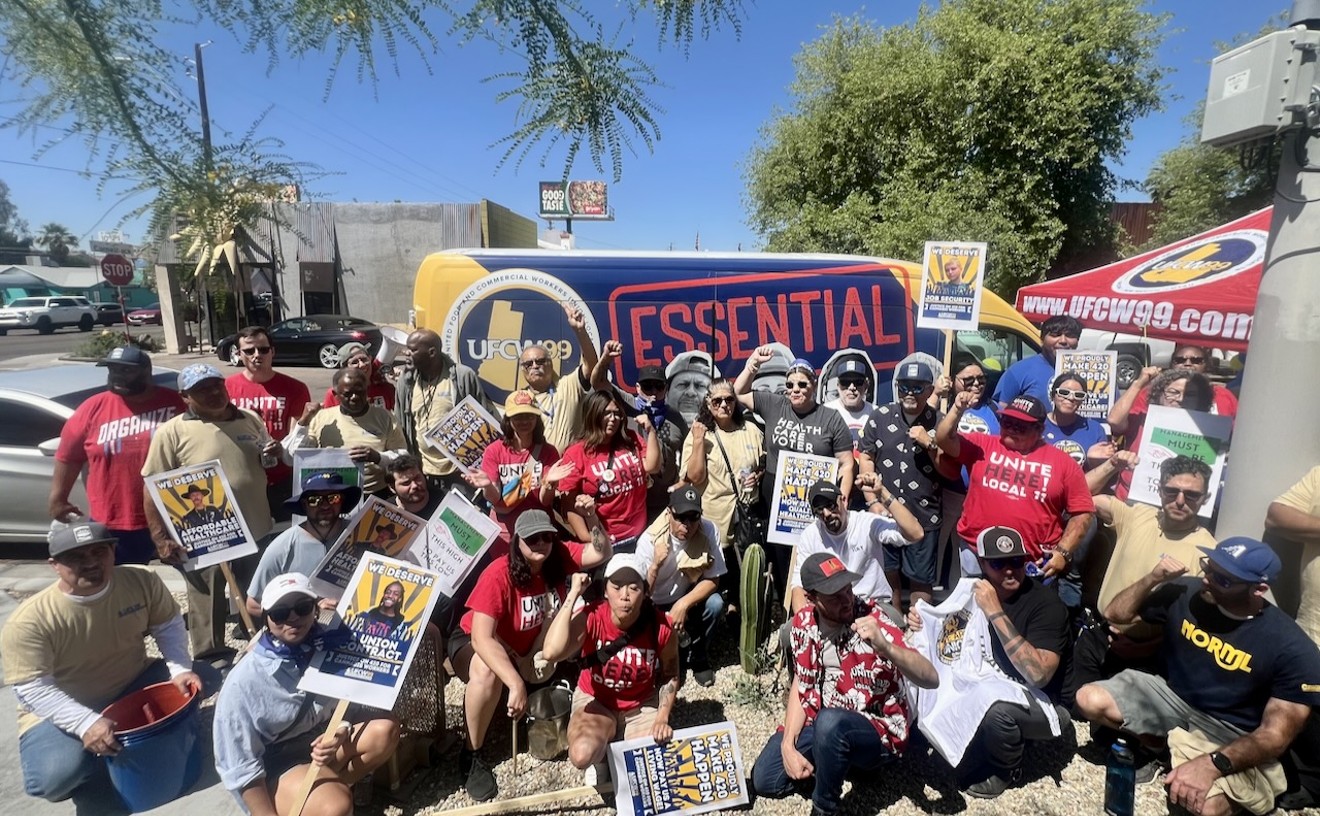Whatever else you might say about Patriots Square, you can credit it with the overdue arrival of architecture criticism in Phoenix. The monsoons of invective that have buffeted the park and its architect, Ted Alexander, haven't all sprung from cool and reasoned analysis, but there's nothing wrong with bloody-fisted emotional reactions to a work of architecture. We ought to flog architects more often; it might help.
Now that the park is open for business, it's time for cool analysis, but this isn't going to be easy--how do you follow lines such as, "TAKE THIS PARK AND SHOVE IT" (New Times, June 29 and July 6)? I feel a little like a TV critic sitting down at year's end, thoughtfully scratching his temple and writing: "Whither Geraldo?"
Well, this isn't going to be that gentle.
Alexander has an anecdote he likes to tell in beginning to explain Patriots Square. A few years ago, he says, he was walking along a sidewalk when a group of tourists, cameras in hand, stopped him for directions.
"Where's downtown?" they asked.
"This is downtown," he replied.
That encounter, he says, confirmed for him the complete failure of downtown Phoenix, both as a place for people and as the city's functional and symbolic heart. It's painfully obvious that he's right: No other big city in North America has such a desolate core. No retail, little entertainment, scant public art and almost no mentionable architecture--the lone distinguished high-rise, Luhrs Tower, is sixty years old, and it is in a state of dereliction.
And there's nowhere for people to gather, no public agora. The Civic Plaza offers a concrete tundra so bleak that people shun it even on cool winter days. Heritage Square is a nice try to save the slim ghosts of Phoenix past, but it has the unhappy whiff of desperation about it--eight old Victorian spinsters huddled together, trying to preserve a trace of dignity as the parking lots lap at their skirts.
When Alexander got the Patriots Square commission, he says, he saw more than an opportunity to create a pleasant little urban park, which is all the city had asked for. He sensed a chance to fix downtown Phoenix.
"There were two other ideas I wanted to explore," he explains. "One was to try to create an evening destination downtown. As it is now, unless you're going to the symphony, you don't go. The other was to make a landmark for Phoenix."
He began with a leitmotif: circles. He believes it's a "friendly" geometric form. Circles, he says, are easy to approach, easy to wander among. Rectangles rebuff people and force them into rigid patterns of movement. In Patriots Square, circles abound. The small circular forms of the planters and incidental benches bite into larger circles enclosing grassy knolls, and all these encircle the semicircular amphitheatre. Cylinders wearing copper hats serve as dressing rooms, food kiosks and elevator terminals. Wander among all these curvilinear forms and notice how they seem to tease and upbraid the relentlessly right-angled buildings and street grid around the park, like clowns bursting in on a dull board meeting. In this role of visual mischief-maker, the park is more than welcome downtown.
Alexander has caught critical hell for dressing the entire park in red bricks, as people imagine all the solar energy they will absorb and re-radiate on a 115-degree summer day. His defense is simple and, I think, adequate: wait till the trees grow. He also views a brick as a humane, congenial object: It fits neatly in the grasp of a hand, and it's a part of everyone's experience. "We've all lived in a home somewhere in the country that was made of brick," he says. "We've all laid brick, even if we just stacked them for shelves in an apartment. A brick is a craftsman thing; you always know a human being laid it."
No quarrel at all here with either the geometry or materials. As you meander among the circles and fountains, the little park seems to exude good cheer. The trouble springs from Alexander's attempt to make it something more than a little park.
Let's start with the dome. No one argues with the idea of shading the amphitheatre, but the dark mood of the structure contradicts all those nice, friendly circles lounging around. It looms over the park like a nightmare-sized tarantula glowering at its doomed prey. Drive by on Central or Washington and you're not sure the park is a place you want to go; the feeling is not so much one of mystery but of vague malevolence.
It's this "feeling," or people's emotional responses to architecture, that so few architects ever figure out how to predict. Some feel uncomfortable even talking about it, as if it were a matter for limp-wristed philosophers. To the great Estonian-American architect Louis Kahn, however, it was the most important element of architecture. Before form, before materials, even before function, Kahn said, the architect must consider feeling.
The spire bursting out of the dome has sparked the most colorful commentary to date. (The laser show, still awaiting another $50,000 in fund-raising, could top it.) In conception, it sounds wonderful: More circles, semicircles and light globes leapfrogging rhythmically into the sky, frozen in a joyous and intricate ballet. In execution, it's too busy to seem rhythmic, and too odd to exude joy. And it's dated. It looks like a Martian obelisk from a sci-fi flick of the Fifties, or like a Frank Lloyd Wright knockoff--look at Gammage Center. However, even when he was being silly--look at Gammage Center--Wright was able to invest his work with poetic grace. Alexander's spire isn't a poem, just an overly busy advertisement. And considered as an ad, as a city symbol, the question nags: What does it have to do with Phoenix?
Alexander thoughtfully worked out part of the nighttime destination problem. After dark, the park turns into a light show. The trees blink with twinkle lights, their canopies are sprayed with uplighting from the planters, and downlights illuminate the grass and brick paving. The light level is high to provide a sense of safety, yet it's mostly ornamental and indirect. Parkgoers aren't bathed in glare. The problem, which is not Alexander's fault, is that there aren't any parkgoers--there's nothing else to lure them downtown. He's betting on the laser to fix that. It seems like an awful lot to ask of a beam of light.
EVEN AFTER THREE YEARS of nonstop defending of the park, Ted Alexander plunges into an interview brimming with enthusiasm. He never tires of explaining it --nor of describing how he expects it to pump up Phoenix's sagging image. He has a naive, childlike exuberance mixed with an adult ego in grand bloom; each of these characteristics renders the other tolerable. Even a skeptic, spending a couple of hours listening to the gospel of Patriots Square and its laser show, is tempted to go away liking the guy and his dream. We're talking about the concept of the user-friendly laser, for example, when he serves up this line: "I want to give them the keys to the magic of the future." I doubt that even Carl Sagan has said anything like that out loud, but in a way, I admire Alexander for it. He seems to mean it.
I ask how he feels about all the derision. "I can't tell you it didn't hurt at times," he says. "But I decided long ago that I was going to have a career where I did things out of conviction, and that sometimes those things were going to be different. The forms, geometry, architecture and entertainment elements in this park are different. Things that are different stretch our minds, and sometimes, to some people, they're unintelligible."
I don't think that's the problem with Patriots Square. In fact, the problem is precisely the opposite: It doesn't stretch the mind. It isn't big enough to provide a sense of evolving drama as you walk through it, as does Lawrence Halprin's wonderful Lovejoy Plaza in Portland, Oregon. It isn't a soaring, spellbinding civic symbol, such as Eero Saarinen's Gateway Arch in St. Louis--although Alexander has ego-fed dreams about the laser show doing the same job for Phoenix. It sure as hell isn't the Eiffel Tower, despite what the Arizona Republic tried to suggest in a late surge of boosterism last year. The park just isn't enough to serve as a centerpiece for the country's ninth-largest city. It would have had a smashing impact in the Phoenix of thirty years ago, which is when it should have been built. And now it would be a cherished historical artifact, and we'd all be fighting to keep the city from turning it into a parking lot.
"If a mistake was made with Patriots Square," Alexander says, "it might have been mine for thinking I could do all this with only two acres and three or four million dollars. The original premise of the park was met and exceeded. Whether it's enough for Phoenix remains a real valid question."
It sure is. The question isn't why Ted Alexander didn't design a better park. It's why we didn't demand one. Not a notably introspective city, Phoenix hasn't debated that yet.
In the role of visual mischief-maker, the park is more than welcome downtown.
The dome looms over the park like a nightmare-sized tarantula glowering at its doomed prey. I doubt that even Carl Sagan has said anything like that out loud, but in a way, I admire Alexander for it.










